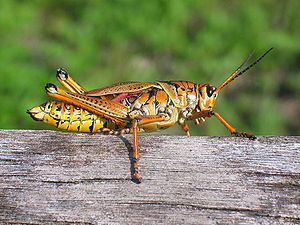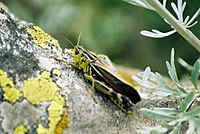Short feeler horror
| Short feeler horror | ||||||||||||
|---|---|---|---|---|---|---|---|---|---|---|---|---|

|
||||||||||||
| Systematics | ||||||||||||
|
||||||||||||
| Scientific name | ||||||||||||
| Caelifera | ||||||||||||
| Ander , 1936 |


The short-antennae terrors (Caelifera) are one of the two suborders of the grasshoppers . About 12,000 species have been described so far. There are around 100 species in Central Europe .
description
The body length of the animals is between 7 and 75 mm, the species Tropidacris cristata can be up to 120 mm long and reach a wingspan of a maximum of 230 mm. Almost all short-antennae terrors are herbivores and feed primarily on grasses and herbs. The small thorns (Tetrigoidea) have largely specialized in algae, mosses and microorganisms.
Like the representatives of the long-feeler terrors , the short-feeler terrors have a very noticeable transformation of the hind legs into jump legs . Further characteristics of the short-feeler terrors are the eponymous short antennae , which in contrast to those of the long-feeler terrors consist of a maximum of 30 members and are sometimes thickened like a club. The animals have compound eyes and chewing-biting mouthparts . The first breast segment is particularly well developed. The fore wings of the animals are narrow and hardened and cover the larger hind wings in the resting position. The hind wings of some species, such as the wasteland horror, can be conspicuously colored blue or red. For oviposition, whereby the eggs are often buried in the ground, the abdomen of the females can be extended telescopically and is equipped with two pairs of strong genital spines (ovipositor valves). The hearing organs of the short-feeler terrors are found on the sides of the first abdominal segment.
Sound generation in the short-feeler terrors
The majority of the worldwide species of short-antennae terrors are noiseless and show optical signals during courtship, such as colorful hind legs, antennas or the wings. Some species are able to produce noises, especially the Gomphocerinae ( grasshoppers ) and Oedipodinae ( wasteland terrors ) , which are widespread in Central Europe . These chants can be used to distinguish the species well. Some groups of species (such as the Pneumoridae native to South Africa) produce very loud chants. In some groups, the hind legs are rubbed against the veins of the forewings while making the noise. Often either the legs (Gomphocerinae) or a wing vein (Oedipodinae) are equipped with teeth and the opposite side with a sharp edge. In addition to these stridulation noises, there are also other noises, such as flight snarling, drumming with the hind or middle legs or sounds generated by the mandibles , such as those made by the Italian beautiful bug (Calliptamus italicus). The singing of the males mainly serves to find a partner. In some species, the female is also able to utter a response song. In many species there are several male song types. The normal song serves to attract the females. The commercial chant is uttered near a female and is often much quieter than normal chant. In addition, there is often a rival song that is uttered when other males are present. Some species also produce a "jump-off" sound just before mating. Despite the specificity of the locust chants, there are occasional mismatches between species with similar chants.
Systematics of short-lived fright

In addition to the well-known grasshoppers of the genera Chorthippus , Omocestus and Stenobothrus , the family of field locusts also includes the notorious migratory locusts such as the desert locust (Schistocerca gregaria) and the European migratory locust (Locusta migratoria) , which, however, only make up a very small proportion of the high biodiversity of the Group. Migratory locusts are not a taxonomic group, but can be found in various families and subfamilies of field locusts. This family also includes Valanga irregularis and Heteropternis obscurella , two species that are widespread in Australia.
The following system lists all, down to the family level, and also the most important species, of the short-lived terrors that occur in Central Europe .
Superfamily Acridoidea
Field locust family (Acrididae)
-
Acridinae
- Common nasal insect - Acrida ungarica
-
Creaks - Calliptaminae
- Italian beautiful insect - Calliptamus italicus
- Alpine Mountain Shrimp - Miramella alpina
- Common mountaineer - Podisma pedestris
-
Cyrtacanthacridinae
- Egyptian migratory locust - Anacridium aegyptium (introduced)
-
Wasteland Horror - Oedipodinae
- Red-winged snare insect - Psophus stridulus
- Horse insect - Celes variabilis
- Blue-winged Badlands Cricket - Oedipoda caerulescens
- Red-winged wasteland insect - Oedipoda germanica
- The spotted snare shrimp, Bryodemella tuberculata
- Blue-winged sand insect - Sphingonotus caerulans
- European migratory locust - Locusta migratoria
- Green wreckage - Aiolopus thalassinus
- River Beach Insect - Epacromius tergestinus
- Marsh Grasshopper - Stethophyma grossum
- Leek insect - Mecostethus parapleurus
-
Grasshopper - Gomphocerinae
- Great Mute Insect - Arcyptera fusca
- Small mute insect - Arcyptera microptera
- Spotted club insect - Myrmeleotettix maculatus
- Red club insect - Gomphocerippus rufus
- Siberian mace insect - Gomphocerus sibiricus
- Great golden terrestrial - Chrysochraon dispar
- Little golden insect - Euthystira brachyptera
- Swiss golden insect - Podismopsis keisti
- Mountain Grasshopper - Stauroderus scalaris
- Field grasshopper - Chorthippus apricarius
- Steppe grasshopper - Chorthippus vagans
- Gravel bar grasshopper - Chorthippus pullus
- Nightingale grasshopper - Chorthippus biguttulus
- Brown grasshopper - Chorthippus brunneus
- Misunderstood grasshopper - Chorthippus mollis
- White-rimmed grasshopper - Chorthippus albomarginatus
- Meadow Grasshopper - Chorthippus dorsatus
- Marsh grasshopper - Chorthippus montanus
- Common grasshopper - Chorthippus parallelus
- Colorful grasshopper - Omocestus viridulus
- Multi-bellied grasshopper - Omocestus rufipes
- Red-bodied grasshopper - Omocestus haemorrhoidalis
- Black-spotted grasshopper - Stenobothrus nigromaculatus
- Heather Grasshopper - Stenobothrus lineatus
- Small heather grasshopper - Stenobothrus stigmaticus
- Dwarf grasshopper - Stenobothrus crassipes
Superfamily Tetrigoidea
The thorn terrors (Tetrigidae) occur with six species in Central Europe. Typical of this group of species is the pronotum, which is elongated to the rear and protects the abdomen and wings. Until 1998 this group was considered silent. However, recent research has shown that the species generate vibrations by drumming their middle legs. In courtship, however, mainly optical signals are used.
Family of thorns (Tetrigidae)
- Saber-thorn insect - Tetrix subulata
- Western thorn insect - Tetrix ceperoi
- Turk's thorn insect - Tetrix tuerki
- Common Dornschrecke - Tetrix undulata
- Long-feeler thorn insect - Tetrix tenuicornis
- Two-spotted thorn insect - Tetrix bipunctata
Superfamily Tridactyloidea
Family of grave insects (Tridactylidae)
There are only two species of this group in Central Europe, both in southern Switzerland and Austria. The most common species is Pfandler's grave insect ( Xya pfaendleri ). In the Mediterranean area, for example, there is Xya variegata , which lives in self-dug caves near the shore and feeds on algae.
literature
- Heiko Bellmann : Locusts: observe, determine , Naturbuch Verlag, 1993, ISBN 3-894-40028-5
- Heiko Bellmann: grasshoppers. The voices of 61 native species. CD, Amp Europe, 2004, ISBN 3-935-32948-2
- Siegfried Ingrisch, Günther Köhler: The locusts of Central Europe , Westarp Sciences, 1998, ISBN 3-894-32461-9
- Peter Detzel: Locusts of Baden-Württemberg , Ulmer Verlag, Stuttgart 1998, ISBN 3-800-13507-8
- Josef Szij: The jumping horrors of Europe , The New Brehm Library Volume 652, Westarp Sciences, Hohenwarsleben 2004, ISBN 3-894-32910-6
- Heinrich Tauscher : Our grasshoppers , Kosmos Franckh'sche Verlagsbuchhandlung, Stuttgart 1986, ISBN 3-440-05617-1
- Bertrand & Hannes Baur, Christian & Daniel Roesti: The locusts of Switzerland . Haupt Verlag, Bern 2006, ISBN 3-258-07053-9
Individual evidence
- ^ Cigliano, MM, H. Braun, DC Eades & D. Otte. Orthoptera Species File. Version 5.0 / 5.0. [02/07/2019]. < http://Orthoptera.SpeciesFile.org >
- ↑ Alexander A. Benediktov (1998): Acoustic Signaling of Grasshoppers of the Genus Tetrix (Orthoptera, Tetrigidae). Zoologicheskii Zhurnal 9: 1021-1025
